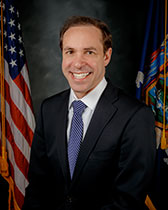
Below are the May Medical Staff Updates. As a reminder, all providers must complete the attestation at the bottom of this page by May 31.
Medical Leadership Message
 Already in the first months of 2016, Kaleida Health has made significant progress on some of its top initiatives.
Already in the first months of 2016, Kaleida Health has made significant progress on some of its top initiatives.
The second quarter of this year started with a change in Medical Executive Committee leadership. Last month, George Matthews, MD, finished his term as Kaleida Health Medical/Dental Staff president after an extremely successful two years. We thank him for his exceptional leadership. On April 1, Peter Winkelstein, MD, took over as the Medical/Dental Staff president for the next two years. A number of new members were also elected to the Medical Executive Committee joining the existing members. We welcome them and wish them success in the two years ahead.
Last month’s Medical/Dental Staff Semiannual Meeting was a great success. Attendance broke records with standing room only. Guest speaker, New York State Commissioner of Health Howard Zucker, MD, JD, addressed the audience with a very dynamic speech.
The second phase of the Leading with CARE initiative will be starting soon, with the initial training of Kaleida Health’s leadership and class facilitators beginning in May. The main emphasis of the second phase will be leadership, quality and patient safety.
Hospital acquired infections (HAI) remain Kaleida Health’s quality focus this year. HAIs are part of the CMS Value Based Purchasing program, and a significant amount of reimbursement is tied to the reduction of the five most common HAI. Five teams are working diligently to reduce the number of these HAI, and we will continue to share progress on reducing infections across Kaleida Health in the Medical Staff Updates.
Results of the 2015 Employee and Physician Engagement Surveys have been released. Participation for both surveys almost doubled this year, and action plans for the survey metrics are underway.
In addition, union contract negotiations are still continuing and expected to go well into the summer.
As Kaleida Health works to continue improving important quality, engagement and patient satisfaction metrics, we thank our providers for their dedication and commitment to making a difference for their patients, visitors and colleagues.
David Hughes, MD, MPH
Chief Medical Officer
Kaleida Health
Kenneth Snyder, MD, PhD
Vice President, Physician Quality
Kaleida Health
Colin McMahon, MD
Chief Medical Officer
Buffalo General Medical Center
David Pierce, MD, FACEP
Chief Medical Officer
Millard Fillmore Suburban Hospital and DeGraff Memorial Hospital
Stephen Turkovich, MD
Chief Medical Officer
Women & Children’s Hospital of Buffalo
Kamil Alpsan, MD
Site Medical Director
DeGraff Memorial Hospital
Message from the President of the Medical/Dental Staff
As I begin my two-year term as president of the Kaleida Health Medical/Dental Staff, it is an honor and privilege to serve you in this capacity. The president does not serve alone, and I am fortunate to have a strong team of officers, committee chairs and Medical Executive Committee (MEC) members with me. Your MEC officers and committee chairs are:

- President Elect: Timothy Haley, MD
- Treasurer: Michael Beecher, MD
- Secretary: K. Kent Chevli, MD
- Credential Committee Chair: Russell Vaughan, MD
- Peer Review Chair: Mike Pizzuto, MD
- Credentials Committee Associate Chair: Dennis Weppner, MD
- APP Chair: Jeremy Essman, PA
Serving on the MEC is a significant responsibility and commitment. I welcome our MEC members and thank them in advance for their efforts. These are your newly elected representatives on the MEC and have agreed to volunteer their time in service of the Medical/Dental Staff:
- Richard Gilbert, MD
- Anne Marie Reynolds, MD
- Alan Posner, MD
- Molly Moore, MD
- Lucy Mastrandrea, MD
- Michelle Penque, MD
- David Carlson, Jr., MD
- Christopher Bartolone, MD
- Michael Mineo, MD
I would also like to recognize those members of the MEC whose terms have finished. Their dedicated service to the Medical/Dental Staff has helped advance quality and improve patient and provider satisfaction throughout Kaleida Health. Please accept my deepest thanks and appreciation:
- Richard Kaplan, MD
- Joanne Massucci, MD
- Andrew Covey, MD
- David Miller, MD
- John Pastore, MD
- Andrew Symons, MD
- Jody Leonardo, MD
Thank you also to those who attended the April Medical/Dental Staff dinner. This event sold out with the largest attendance ever. Howard Zucker, MD, JD, the New York State Commissioner of Health, gave us an interesting and insightful talk. Please watch for the announcement of our fall event.
Last, but far from least, I would like to personally thank George Matthews, MD, for his outstanding service as our president. George gave us insight, compassion and dedication; he greatly advanced the work of MEC. I “stand on the shoulders of giants,” and George is among the tallest.
Peter Winkelstein, MD, MS, MBA, FAAP
Medical/Dental Staff President
Kaleida Health
Hospital-Acquired Conditions: Catheter-Associated Urinary Tract Infections
Kaleida Health’s top quality and patient safety priorities in 2016 focus on reducing hospital-acquired conditions (HAC). One of the top five HAC across Kaleida Health is catheter-associated urinary tract infections (CAUTI), and Ken Snyder, MD, PhD, vice president of physician quality at Kaleida Health, is leading the reduction and prevention efforts.
Even though the morbidity and mortality of CAUTI is low compared to other hospital-acquired infections, the high use of indwelling urinary catheters causes a large number of urinary tract infections and deaths. The act of inserting a catheter results in bacterial colonization in the bladder at a rate of three percent per day. By the end of one week, the catheterized patient’s risk of bacteriuria is 25 percent, and after 30 days, 100 percent of indwelling catheters are colonized with bacteria.
The National Healthcare Safety Network (NHSN) of the Centers for Disease Control and Prevention (CDC) is the nation’s database for healthcare-associated infection tracking. Infections are identified through surveillance conducted by the infection preventionists.
The definition of a CAUTI is a urinary catheter for greater than two days and present at the time of culture or removed the day before and greater than 105 CFU/mL organisms and any single sign/symptom related to the urinary tract (fever, suprapubic tenderness, costovertebral angle pain or tenderness (urgency, frequency, dysuria only if the catheter is pulled out)).
In order to reduce the number of infections, consider ordering a urinary catheter only if it meets the appropriate indications for use – acute urinary retention, acute bladder outlet obstruction, the need for accurate measurements of urinary output in the critically ill, to assist in healing of open sacral or perineal wounds in incontinent patients, if needed to improve comfort for end of life, in patient who requires strict prolonged immobilization, and with selected perioperative needs. Nurses and providers should not routinely insert and order urinary catheters for indications outside the listed indications. If a patient meets criteria for insertion, diligent daily assessment to evaluate the removal of the urinary catheter as soon as possible is best practice in order to avoid CAUTI.
It is important to reflect back to the definition of a CAUTI and evaluate current clinical practices. Avoid routine cultures, including when a catheter is removed, and only culture for urinary symptoms. Other symptoms do not correlate with CAUTI in adults. Do not treat asymptomatic bacteriuria, and keep in mind, pyuria is not an indication to treat bacteriuria.
Three key focuses – avoiding insertion unless there is an appropriate indication for use, removing the catheter as soon as possible, and only culturing for urinary symptoms – will better serve our patients and reduce our infection rates.
Semiannual Meeting Review
 On April 14, 2016, Kaleida Health hosted the Medical/Dental Staff Semiannual Meeting. The group was happy to have Howard Zucker, MD, JD, New York State Commissioner of Health, as the keynote speaker.
On April 14, 2016, Kaleida Health hosted the Medical/Dental Staff Semiannual Meeting. The group was happy to have Howard Zucker, MD, JD, New York State Commissioner of Health, as the keynote speaker.
As you will see in the video presentation, Dr. Zucker described the doctor-patient relationship and the efforts the New York State Department of Health is making with cancer screening, tobacco use, supportive housing for people with complex health conditions, and opioid addiction. He also discussed how primary and tertiary care providers can work together to better coordinate patient care.
Prior to Dr. Zucker’s presentation, Peter Winkelstein, MD, president of the Medical/Dental Staff, and Jody Lomeo, president and CEO of Kaleida Health, provided updates on Kaleida Health’s medical affairs and operations. David Hughes, MD, MPH, chief medical officer of Kaleida Health, followed Dr. Zucker’s presentation with an update on Kaleida Health’s quality, patient satisfaction and physician engagement efforts.
Clinical Research: Targeting Polyamines using DFMO in Persons with Type 1 Diabetes
The Diabetes Center at Women & Children’s Hospital of Buffalo is participating in a Phase 1 clinical trial sponsored by the Juvenile Diabetes Research Foundation to study the repurposing of an existing drug known as alpha difluoromethylornithine (DFMO) in order to characterize its effects in persons with new onset type 1 diabetes.
Type 1 diabetes is caused by autoimmune destruction of the insulin producing beta-cells in the pancreas. Individuals with the disease are completely reliant on insulin for survival.
The study is based on preliminary data from scientists in the laboratory of Raghu Mirmira, PhD, MD, an islet cell biologist at Indiana University. Dr. Mirmira’s laboratory studies polyamines, which are small molecules important in governing cell growth, proliferation and survival.
In preliminary studies using a mouse model of new onset diabetes, animals treated with DFMO, an inhibitor of polyamine synthesis, had sustained beta-cell insulin production and delayed diabetes onset. Polyamine modulation has the potential to improve beta-cell health. This study translates the animal studies into a proof-of-concept dose-ranging bench-to-bedside study to examine the impact of polyamines on insulin secretion and clinical outcomes in persons with recent-onset type 1 diabetes.
Researchers plan to treat persons with recent-onset type 1 diabetes with one of up to six different doses of DFMO in order to find the dose that has the best effects on polyamine synthesis as well as characterize the safety of this medication. Persons (age 12-40 years) in this trial will come in for up to five study visits and have assessments of beta-cell health, insulin production, immunologic function, and diet.
Lucy Mastrandrea, MD, PhD, serves as the site investigator at Women & Children’s Hospital of Buffalo. Linda Dimeglio, MD, Indiana University, is the lead principal investigator for the study. Researchers anticipate that this trial will be followed by a second study once they have determined the optimal dose. Data from this project are essential to guide the design and conduct of future, fully-powered studies.
To learn more about this study and other clinical trials being performed by the Division of Pediatric Endocrinology at Women & Children’s Hospital of Buffalo, please call 878-7588 to speak with a member of the research team.
Medical Executive Committee - Department Presentations
Minimally Invasive Gynecologic Surgery – Presented by Armen Kirakosyan, MD, FACOG, FPMRS, FRCSC, FACS
Currently, I am board certified in Obstetrics and Gynecology and in Female Pelvic Medicine and Reconstructive Surgery (Urogynecology). Also I am certified by Royal College of Physicians and Surgeons of Canada.
I came to Buffalo three years ago and joined the General Physician, PC (GPPC) OB/GYN team. Initially, I operated only at Millard Fillmore Suburban Hospital (MFSH) while developing my practice.
In 2014, Gil Farkash, MD, FACOG, chief of service for OB/GYN, asked me to do cases at Buffalo General Medical Center (BGMC). With the great help of administration, specifically Jeff Holt and Cheryl Klass, we started to develop the GYN minimally invasive surgery program. In January 2015, I was appointed the director of Minimally Invasive Gynecologic Surgery.
The development process entailed providing training sessions to operating room staff, going over the equipment, instruments and GYN procedures. New hysteroscopic equipment was acquired. Laparoscopic GYN instrument sets were establishes. A position was created for the Robotic/GYN coordinator. We implemented and have been holding robotic committee meetings every several months. The robotic operating room was rearranged to accommodate the needs of all subspecialties. Our room now is well organized and has more space than before.
My operating room team accompanied me to MFSH to watch and scrub with me on my cases. This allowed everybody to be trained simultaneously and get up to speed within several months.
Currently, BGMC can offer an entire spectrum of minimally invasive gynecologic procedures, including hysteroscopic, laparoscopic and robotic. With the new hospital opening in 2017, we are ready to accommodate any GYN surgeries.
Policy Updates for Providers
Below is a new policy that affects providers at Kaleida Health. Please take a moment to review this month's updates. The policy link below is accessible from a Kaleida Health computer only. For additional assistance, please contact Amy Palombo at apalombo@kaleidahealth.org or 716-859-8447.
New Policy:
IT.28 – Electronic Prescribing of Controlled Substances
Medical Staff Attestation - May 2016
By submitting this attestation, I confirm that as a member of the medical staff I have read and understand the information included in this email from Kaleida Health in accordance with Kaleida Health policy MED.41 as approved by the Medical Executive Committee.
| Fields marked with an asterisk (*) are required. |
|
|